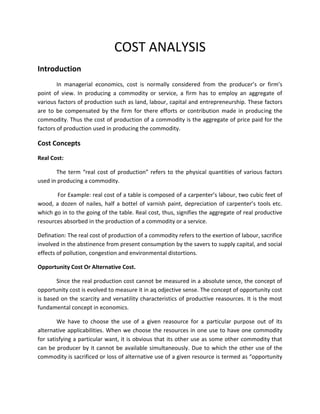
Cost Analysis Breakdown
- 1. COST ANALYSIS Introduction In managerial economics, cost is normally considered from the producer’s or firm’s point of view. In producing a commodity or service, a firm has to employ an aggregate of various factors of production such as land, labour, capital and entrepreneurship. These factors are to be compensated by the firm for there efforts or contribution made in producing the commodity. Thus the cost of production of a commodity is the aggregate of price paid for the factors of production used in producing the commodity. Cost Concepts Real Cost: The term “real cost of production” refers to the physical quantities of various factors used in producing a commodity. For Example: real cost of a table is composed of a carpenter’s labour, two cubic feet of wood, a dozen of nailes, half a bottel of varnish paint, depreciation of carpenter’s tools etc. which go in to the going of the table. Real cost, thus, signifies the aggregate of real productive resources absorbed in the production of a commodity or a service. Defination: The real cost of production of a commodity refers to the exertion of labour, sacrifice involved in the abstinence from present consumption by the savers to supply capital, and social effects of pollution, congestion and environmental distortions. Opportunity Cost Or Alternative Cost. Since the real production cost cannot be measured in a absolute sence, the concept of opportunity cost is evolved to measure it in aq odjective sense. The concept of opportunity cost is based on the scarcity and versatility characteristics of productive reasources. It is the most fundamental concept in economics. We have to choose the use of a given reasource for a particular purpose out of its alternative applicabilities. When we choose the resources in one use to have one commodity for satisfying a particular want, it is obvious that its other use as some other commodity that can be producer by it cannot be available simultaneously. Due to which the other use of the commodity is sacrificed or loss of alternative use of a given resource is termed as “opportunity
- 2. cost” thus the opportunity cost is measured in terms of the forgone benefits from the next best alternaive use of a given resource Importance of the concept of opportunity cost: 1 Determination of Relative Price of Goods. 2 Determination of Normal Remuneration to a Factor. 3 Decision Making and Efficient Resource Allocation. Money Cost. Cost of production measured in terms of money is called the money cost. “Money Cost” is the monetary expenditure on inputs of various kinds- raw materials, labours, etc., required for the output. It is the money spent on purchasing the different units of factors of production needs for producing a commodity. Money cost os oviously the payment made for the factors in terms of money. Money cost is the outlay cost, i.e., the actual financial expenditure of the firm. Explicit and Implicit Costs. Explicit costs refer to the actual money outlay or out of pocket expenditure of the firm to but or hire the productive recource it needs in the process of production. It is referred to as out-of-pocket costs for example. Cost of raw materials; wages and salaries; power charges; rent of business or factory premises; intrest payments of factory premises. Etc. Implicit Cost. Implicit cost is not directly incurred by the firm through market transaction. But nevertheless are to be reckoned in the measurement of total money costs of production. These are to be imputed or estimated on the bases of opportunity cost, i.e., from what the factors by the firm itself could earn in their next best alternative employment. Accounting And Economic Costs An economist’s idea of cost of production differs from that of an accountent. In economics the cost of production consists of all the factors that are involved in producing a particular commadity for example wages for the labours, raw materials, normal profit to the entrepreneur, but an accountant considers the explicit cost i.e the cash payment to the factors of production, maid by the entrepreneur, for the srevice rendered dy these factors in the productive process for example: wages, intrest, rent payment but not the profit maid by the
- 3. entrepreneur because no entrepreneur ever makes cash paymenys to himself. In common practice also, we donot tend to regard profit as part of a firm’s cost of production. Fixed And Variable Costs Fixed cost Fixed costs are the amount spent by the firm on fixed inputs in the short ryn. Fixed costs are, thus, those costs which remain constant, irrespective of the level of output. These costs remain unchanged even if the output is nil. Fixed costs, therefore, are known as “supplementary costs” or “overhead costs.” Some of the fixed costs are: Payments of rent for building. Intrest paid on capital. Depreciation and maintenance allowances. Administrative expenses. Variable Costs or Prime Costs Variable costs are those costs that are incurred on various factors. These factors vary directly with the level of output. In other words, varable costs are those costs which rise when output expands and fall when output contracts. When output is nil, they are reduced to zero. The varable cost include: Price of raw materials, Wages of labour, Fuel and petrol charge, Excise duties, sales tax.
